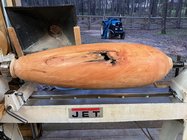A while back I purchased a ROS for doing the finishing work on my large hollow forms. It's been a huge improvement in my ability and results when sanding large hollow forms that are 15 - 30+ inches tall. It can be tough to get a clean smooth surface, keep the flow of the curve and have no swales or ridges over that much distance. At least for me. With a high gloss finish the surface needs to be free from undulations or they'll show. With the ROS and the 5" pad I can glide it up and down the vessel and easily spot where there's a ridge or a swale in the surface and work over them until gone and blended in. With practice and a good pad I can go up around sharper curves toward the opening or base and still watch for imperfections in the surface. They also leave a very nice sanded finish. In all the years of doing woodworking I've never owned one. Wish I had sooner.
Every time I post in this section I wonder if I'm repeating something already covered or something everyone else knows but me. I searched but didn't find a discussion on the topic. Sorry if a repeat.
Every time I post in this section I wonder if I'm repeating something already covered or something everyone else knows but me. I searched but didn't find a discussion on the topic. Sorry if a repeat.

